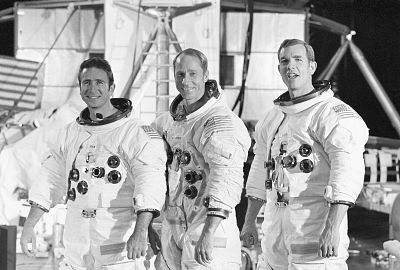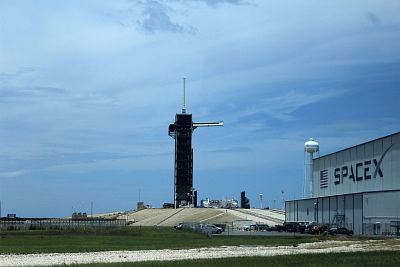Al Worden, now 87, orbited the moon for three days in the summer of 1971.
Out past the gates at the Kennedy Space Center along Florida's Atlantic Coast, Al Worden was on his way to the launch pad where he and his Apollo 15 crewmates blasted off for the moon almost a half-century ago.
"We used to have a lot of fun here and we did a lot of our training here," the retired NASA astronaut said Friday, as he led a tour group along roads that offered views not only of alligators and eagles' nests but also of the past, present and future of America's space program.
Worden, 87 and as sharp as the tip of a spaceship, recalled the hard work and isolation but also the camaraderie of astronauts back in the day. "I think all the guys back in the program were Type A people and they didn't take no for an answer," he told the group. "They were very aggressive, very outward going, very talkative, loved to tell stories."
And, he said, they didn't always follow the rules.
Three weeks before liftoff, Warden recalled, astronauts were quarantined to help them avoid exposure to illness-causing germs — or at least that's what was supposed to happen. "We did a lot of things that probably were against what was written down somewhere," he said with a smile. "But we took care to look after each other, and nobody ever got caught."
Worden also recalled training for a little-publicized "rubber room" deep beneath their launch pad. It was a reinforced shelter designed primarily for workers on the pad, to be used in the event of an imminent explosion during fueling or a countdown. But there was a way for astronauts atop the rocket to get to it, too. They could open the hatch, sprint to an elevator and ride a 200-foot slide to the bunker.
"There's a chute that goes down, it's like a Disney ride," Worden said. "You get going on this thing and you go really, really fast cause it's all Teflon-coated ... and you go sailing across the rubber room and hit the opposite wall and that's what stops you. We used to do that quite a bit. We had to have some fun with something!"
Long-awaited anniversary
Worden led the tour as part of events marking the 50th anniversary of the Apollo 11 mission. The tour came almost 50 years to the day after the Apollo 11 capsule splashed down in the Pacific Ocean following its historic mission to the lunar surface — and exactly 48 years after Worden and his Apollo 15 crewmates, David Scott and James Irwin, lifted off on July 26, 1971.
Space
Apollo 15 focused on science. Worden orbited the moon alone in the command module Endeavor for three days, conducting experiments and photographing the lunar surface while Scott and Irwin explored and gathered samples below, using the first of three lunar rovers brought to the moon by Apollo missions.
"It was a very, very busy time," Worden recalled, adding that when there was time to rest, falling asleep in space took a little getting used to.
A young man on the tour asked Worden what it was like to dream in space. "Son, I don't dream," he replied. "I had no dreams. When I go to sleep, I sleep. I don't waste energy dreaming. Never have dreamed … Slept well, though."
On the way back to Earth, Worden stepped out of the speeding capsule and carried out the Apollo program's first deep-space spacewalk some 200,000 miles from Earth.
The Apollo 15 crew splashed down in the Pacific on Aug. 7, 1971.
Changed world at the cape
Worden retired from NASA in 1975 and has served in several positions in the aviation and aerospace industries since then. He's also written three books, and his skills as a storyteller were on full display as the tour group arrived at Launch Complex 39A, the facility that hosted Apollo and Space Shuttle launches — and which is now used for commercial launches.
"This is all different than what we had," Worden said, pointing out a sleek black tower and crew access arm that has replaced the open, erector-set-like gantry that the Apollo astronauts used to reach their capsules. "SpaceX has built this absolutely futuristic-looking gantry up here. It's all enclosed, a nice little hallway going out there. Pretty slick."
It was clear to the visitors, a group of 42 who included older adults as well as boys and girls, that the Kennedy Space Center is a busy spaceport. Several launch pads at the center have seen increased activity in recent years as companies such as SpaceX, United Launch Alliance and Jeff Bezos' Blue Origin have moved in.
One day before the tour, a SpaceX rocket had lifted off from a launch pad a few miles away from Worden's. Space center visitors at a viewing site 3.4 miles from the pad watched as a Falcon 9 soared skyward atop a plume of white smoke and flames on its way to the International Space Station.
"I'll never ever forget this," a 10-year-old who had witnessed the liftoff said.
Taking humans to a new world
At one point during the tour, Worden gazed at pad 39A in the distance and told a visitor he thinks humans will eventually journey to Mars. But 50 years after humans walked on the moon, he was thinking of even bigger leaps.
"We've got to go way beyond Mars," he said. "Mars is just another step along the way" toward the establishment of new human settlements in space.
A visitor asked Worden if he thought the mission that would deliver humanity to that unknown destination would depart from the space center, as Apollo 15 had so long ago.
"Absolutely," he replied.













